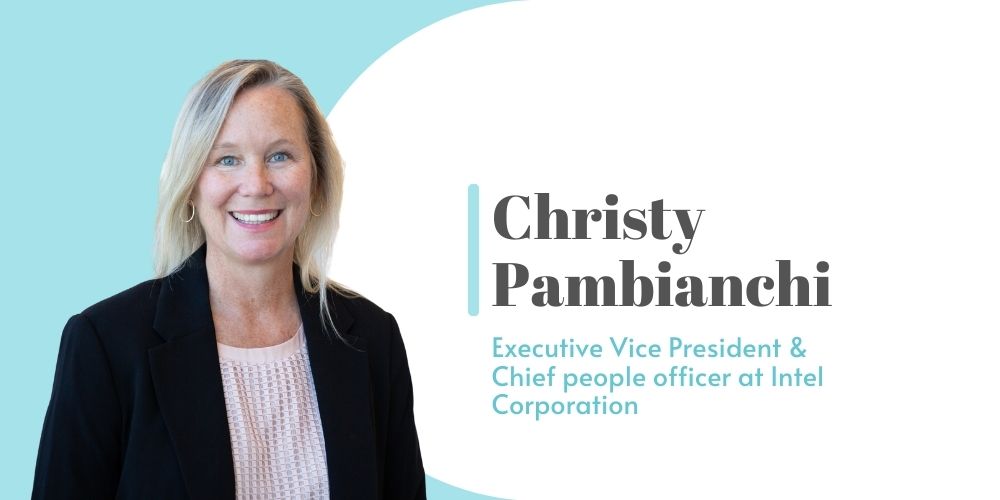In an interview, Christy Pambianchi, EVP and Chief People Officer at Intel, highlights the importance of continuous learning and innovation in HR, emphasizing Intel’s phased approach to implementing AI tools. Diversity isn’t just a value at Intel—it’s fundamental, with initiatives like the Alliance for Global Inclusion driving collective impact. Pambianchi advises startup leaders to prioritize human capital management, stressing the importance of assembling agile teams. Reflecting on boardroom culture, she notes a growing emphasis on human capital and talent strategy. For young professionals, she advocates observing office norms, building networks, and seeking mentorship. Pambianchi’s insights provide valuable guidance for HR professionals aiming to foster inclusion and drive organizational success.

Drawing from your extensive leadership experience—to become this kind of leader and shape a space to co-create, what are the things that an HR leader needs to learn or unlearn?
I’m a firm believer in the importance of lifelong learning, which is part of the reason I love my role at Intel so much. One of the core principles of our people strategy is to foster a culture that celebrates continuous development and learning. And this is just as important for the HR organization. If our role is to shape positive change in the ways that people work, we need to embrace opportunities for continuous improvement and innovation.
Take AI. New AI tools are changing the way we work and even creating fear of the unknown. At Intel, we believe human ingenuity and adaptivity will always be the driver of progress across industries and fields. AI is a complementary tool that can support and expand what people can do today. We’ve been taking a phased approach to roll out new tools and learn how to enable our employees with those tools—all to help them unlock exciting new potential.
Intel’s commitment to diversity and inclusion is evident. Would you characterize diversity as a corporate value at Intel, or do you believe it has naturally evolved over time? How does Intel continue to reinforce and nurture its commitment to diversity and inclusion?
As former Intel Chairman Andy Bryant often said, “The ingredient we start with is sand. Everything else is value added by people.” And a diverse workforce where employees are empowered to bring their unique viewpoints to the table is instrumental in driving innovation and delivering strong business growth.
These efforts aren’t new. We have long believed that a diverse and inclusive workforce is not just the right thing to do, it’s a business imperative. To continue that momentum, we are collaborating with others to broaden access to opportunity and inspire the next generation of innovators.
The Alliance for Global Inclusion, which Intel helped found, is a great example of this work. This coalition of 18 technology companies and adjacent industry peers is focused on driving collective impact in four key areas: leadership representation, inclusive language, inclusive product development, and improving STEM readiness in underrepresented communities.
Startups are known for their fast-paced environment. What advice would you give startup leaders to ensure that human capital management remains a priority amidst their busy schedules?
Whether you’re a startup or a large corporation, talent is the heart of everything. It is incredibly difficult to scale an idea or a business without the right people. My advice is to treat that as job #1. Spend time reflecting on the type of talent that is critical for the ramp of the company and hire the right people. Don’t compromise. Assemble a small and agile team that can iterate quickly, learn, move, and grow—this is a key ingredient to success.
How have you observed the culture of the boardroom evolve over time, and how does this evolution impact HR strategy and decision-making?
Over the last 20 years, standards and expectations around governance have evolved, and what is expected from a board of directors has continued to change. What I have seen is highly open engagement between the board and management; this means a high level of transparency around the business operations and understanding of the work happening inside the company.
In the HR space, there has been an increasing emphasis on human capital over the past decade—a desire to better understand the employee strategy, culture, and how compensation is tied to business performance. Another top priority is talent, including succession planning for the CEO and the rest of the leadership team. Bring those discussions into meetings with the board of directors. Work with the CEO to determine the right times to provide updates to the board and when to have board members contribute input.
I recommend that HR leaders take the time to understand how their board works. This could include:
- Meeting with the Corporate Secretary to learn about processes and procedures
- Attending Committee meetings or Board dinners if possible
- Taking the time to listen and learn at first; less is more while on a steep learning curve
- Serving on a non-profit or other local Board to learn about Corporate Governance
Reflecting on your experiences, what advice would you offer to young professionals as they navigate their careers and strive for personal and professional growth?
I will share the same advice I’ve given to my children as they have begun their career journeys. When you’re first starting, there is a steep learning curve, because you are not only working on the core focus of your job, but you are also learning about the world of work. Take the time to observe and understand the behavioral norms of the office environment, the company values, and how to conduct yourself and engage with colleagues. Treat these aspects of the job like important tasks: building a network, understanding the business environment, and finding a peer mentor who is 1-2 years ahead of you. These will help create a strong base for your career growth.
 |
Christy Pambianchi Executive vice president and chief people officer at Intel Corporation Christy Pambianchi is executive vice president and chief people officer (CPO) at Intel Corporation. As CPO, she is responsible for driving Intel’s people strategy and fostering a vibrant culture focused on bold innovation, flawless execution, and continuous development and learning.Photo: Intel Corp. |
This profile was published in the April 2024 issue of The HR Digest.





